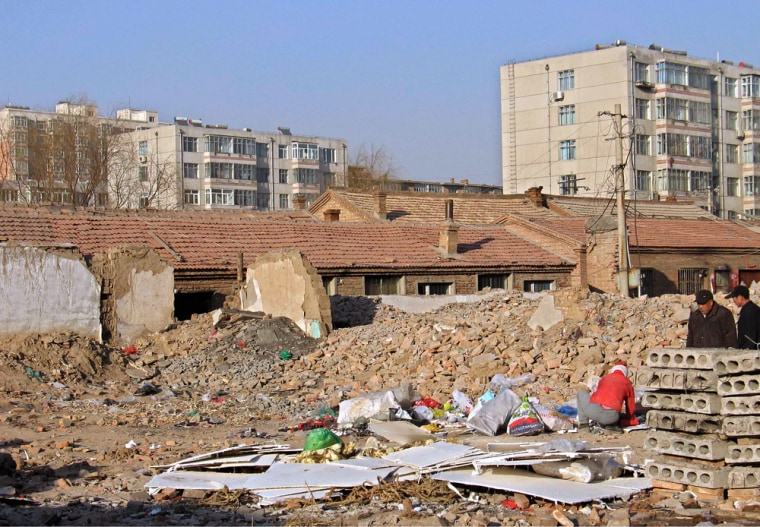To the casual observer Chifeng -- with its smoke stacks, crumbling apartment blocks and decrepit factories -- is just another industrial town trying to find its way in China’s uncertain transition to a market economy.
The city, typical of many poor and polluted inland cities in China, is an unlikely setting for a potential tourist hotspot.
But all that could change come the 2008 Beijing Olympic Games, for Chifeng has been put on a list of tourist sites recommended by the Olympic Games organizing committee.
Chifeng bills itself as the closest place from Beijing to experience the Inner Mongolian grasslands, where Genghis Khan’s warriors roamed centuries ago and where his descendents still live.
The local government has high hopes the Olympic Games will draw foreign tourists to the city, creating jobs and easing the pain of unemployment caused by the closure or privatization of the factories that used to be the city’s economic mainstay.
"If we can get more visitors here on the tails of the Olympics, that’s great," said Li Shuqing, 50, a laid-off worker who opened his own restaurant four years ago.
"For too long Chifeng has been remote, so I hope that we can be more connected to the outside world," Li added. "Maybe we can even get some foreign investment."
Yet Chifeng, referred to on its Chinese language travel Web site as a "flourishing, outstanding tourist city" and a "tourist Mecca", may find it hard to attract large numbers of tourists.
The city has been judged so unworthy of tourism that English language guidebooks, including the iconic Lonely Planet, make not even a passing mention of it.
Indeed, foreign visitors are such an oddity that people stop to stare at them in the street.
"Why on earth would a foreigner want to come here?" said ethnic Mongolian Bataar as he smoked outside Chifeng’s train station, built in a socialist-architectural style that was once considered de rigueur by Communist planners.
"There’s nothing to see in Chifeng."
Building boom
Signs that the government has been spending like crazy to prepare for a possible tourist influx are everywhere.
A huge new administrative hub, complete with Chifeng’s first five-star hotel, rises out of the fields on the outskirts. In the main town, old buildings are being torn down, roads repaved and street lighting improved.
Yet Chifeng may face an image problem.
It is home to a jail identified by Amnesty International as a place where torture takes place -- a prison that houses political detainees like ethnic Mongolian academic Hada, serving 15 years for separatism.
And although the military presence is not obvious downtown, an air base lies on the city’s outskirts.
Despite being situated a relatively close, around 500 or so kilometers (310 miles) northeast of Beijing, communications are inconvenient, though a new highway has cut in half driving time to the capital.
But the fastest train to Beijing still takes about 10 hours.
Chifeng’s quaint, 1950s-era airport is so small that the baggage reclaim area is a raised counter next to two check-in desks. The tarmac can hold just two aircraft -- and small regional jets at that. There are no announcements in English.
Visitors who arrive a little early for one of the three daily flights will find that most lights are turned off, including in the control tower.
Limited sights
To be fair, many of Chifeng’s tourist attractions lie outside the city, in the grasslands and mountains.
Chifeng, whose population of about five million exceeds that of New Zealand, was once the capital of the Liao Dynasty, established by the nomadic Khitan people in 907.
Little remains of that history. There is a 400-year-old mosque and a renovated temple sits incongruously surrounded by mounds of coal and dilapidated housing with broken windows.
Taxi drivers look amazed at being asked to go to the Nanshan Ecological Park, supposedly a top city attraction.
"Really, there’s nothing there," said Li Bin.
He doubts the city will benefit from the Olympic Games.
"Maybe people will stop off here on the way to the grasslands, but they won’t be very impressed by Chifeng".
At another tourist site, the Red Mountains or Hong Shan, the authorities have done their best to welcome foreigners with an oddly worded English sign explaining the area’s sights which apparently include a fossil discovery.
The Chinese sign offers little help in solving the mystery of what the "drugged Hong Shan dinosaur" might have been.
Still, the world’s oldest profession seems to have sensed an opportunity in Chifeng from the hoped-for rush of foreigners.
"Have you come on your own?" asked one woman, her face covered by a mask to keep out the pollution and biting winter cold.
"Do you want a girl for the night?"
